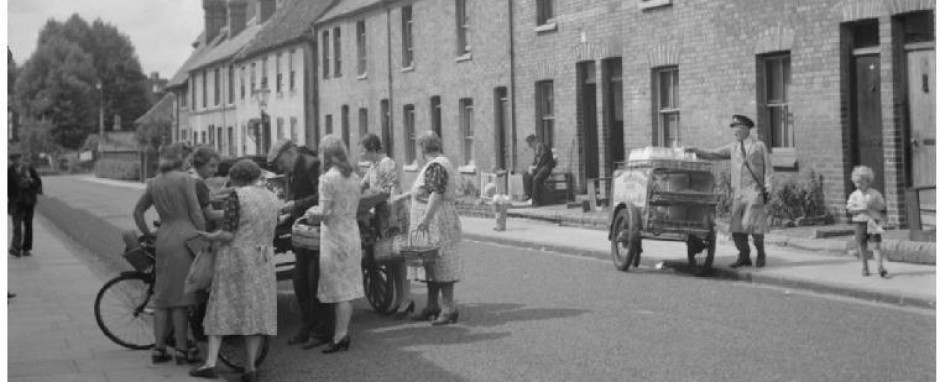This is from ‘Letters’ in the Reading Standard. June 16th 1994 along with a photo of their Coronation [I think] decorations…
My Happy Days in Brook St West. By E. Clift.
As you stated in your issue on May 24th Brook St West has changed beyond all recognition. From about 1926 until my call up into the army in 1939, I lived at no 2 Brook St West, which by my reckoning, was the house next door to where the two ladies are talking. I think I knew both of them.
Just about where they were talking is just about the spot where the Castle Street exit comes off the inner ring road towards Caversham.
My sister returning to Reading from Australia after 30 years, was devastated by the change. Both of us liked Brook St West as it used to be.
It was a working class area, but the sheer quality and character of the people who lived there made it a real privilege to have them as our neighbours. As a matter of fact that went for everybody who lived in Coley. They were all characters they were all genuine and the staff at Coley School bent over backwards to ensure their children grew up in the same mould.
The Holybrook itself also had a lot of character, all the way from Arrowhead, where it came out of the Kennet, to the spot where it re-joined near the Abbey Ruins.
In the 20’s and 30’s it was quite safe for children of the tenderest age to wander about in perfect safety – and most of them did.
All my childhood Coley contemporaries could tell you about The Cundells, The Apses, The Wire Mills, The Silver Bridge, Johnny Bucknell, his sons and his farm.
The whole area was a heaven for anglers and Coley School won the Reading Schools Angling Cup year after year.
But Brook Street West and Brook Street were never all that popular for fishing – though on one occasion I saw a monster barbel landed outside the Borough Arms in Brook St.
What was popular in Brook Street West was the pavement football cup finals which took place daily. Many a pair of boys trousers were ruined as their wearers nipped over the lethal iron railings to retrieve the ball from the river.
The picture with only two ladies in view was quite strange – there were always numerous children around.
The girls played hopscotch, the boys football, and some of both playing with whips and tops, rolling their iron hoops … and marbles had their place too.
One of my personal memories was donning bathing costumes with my brother after dark, and after my father had gone to bed, to try and recover his Great War medals which he had thrown into the river in disgust when Neville Chamberlain returned to England with his infamous ‘peace in our time’ piece of paper.
We only managed to find three, so I presume the other one is still there. I do not know to this day whether my mother ever told him we had recovered three. I feel pretty sure they would have gone back in if she did.
Another thing which intrigues me is how we managed to have such great Christmases in those tiny little houses and how we managed for the rest of the year. Two small bedrooms upstairs, two small rooms downstairs, a scullery cum kitchen in which you couldn’t swing a cat – yet it housed a gas cooker, a large copper and a coal store. The toilet was outside and for a lot of the year you had to be really tough to venture out there.
The back garden was all of 10 foot square, but our dog would clear the fence which we had extended to about 8 foot high with one bound if there was a cat in the next garden.
As the family got older, the sleeping arrangements got very complicated indeed, but they were happy days.
I remember walking to Elm Park to see Reading Reserves with my father – he couldn’t afford to take me to the first team matches – and those great teas when we got home of bloaters cooked in flour…watching Coley School football team win the Reading Schools Cup at Elm Park in front of a crowd bigger than they get for some first team games these days.
I had a great childhood and I have a lot to thank Coley and the Holybrook for.
